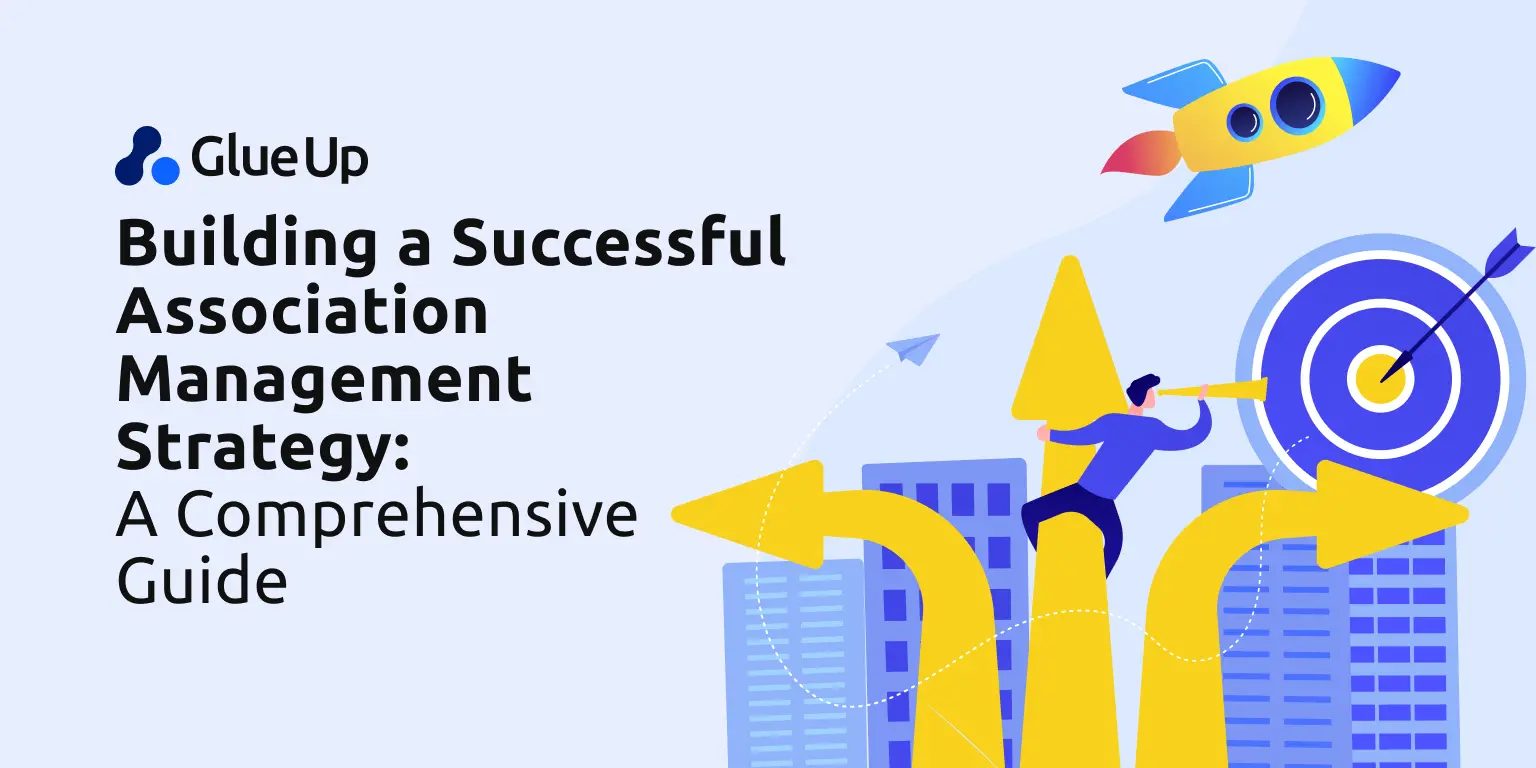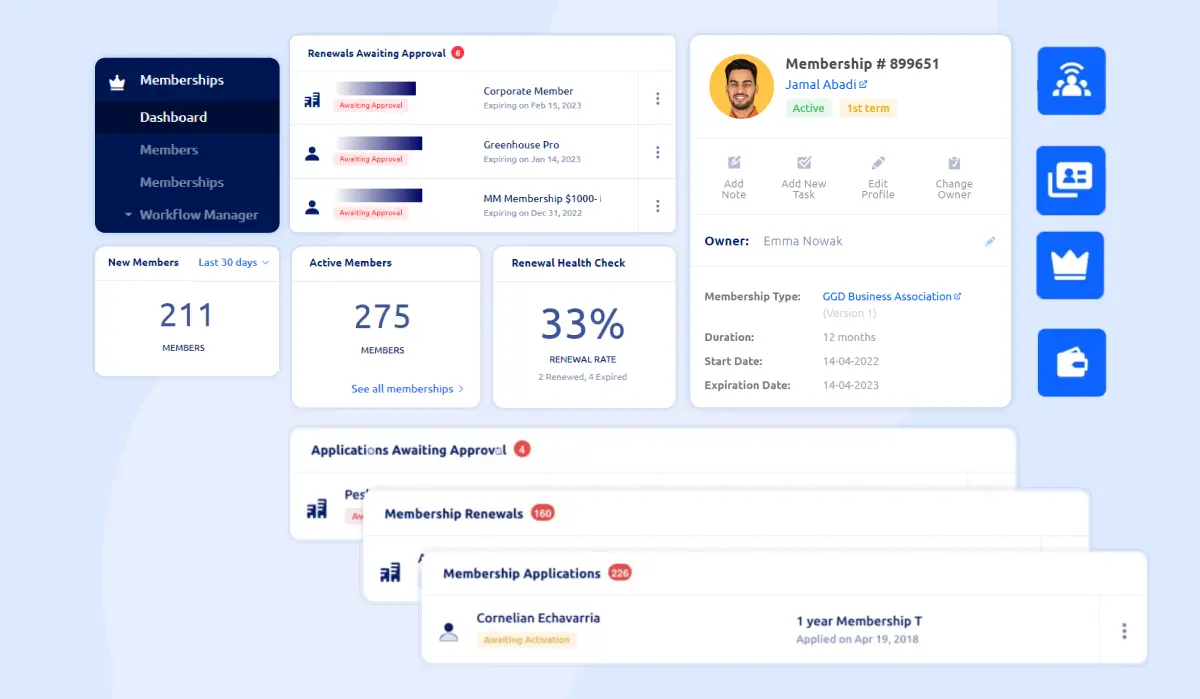
Without a management strategy, it's nearly impossible for any association to function effectively.
Associations without a strategy are bound to face disastrous outcomes, which will result in unproductive results for the organization and its members.
Because there is no set direction on where to go, be it concerns like what to do for member engagement or finance, everything needs planning.
This blog focuses on building such a strategy, covering all the insights needed to create a comprehensive guide. If you're interested in learning more, read on to discover the essential components of a successful management strategy for associations.
Key Takeaways:
-
A well-defined management strategy is crucial for associations to function effectively.
-
Associations can adopt various strategies tailored to their needs, such as revenue growth, streamlining operations, membership engagement, digital transformation, advocacy, and more.
-
Building a successful strategy involves steps like articulating a mission and vision, conducting a SWOT analysis, drafting a strategic plan, defining actionable steps, and translating strategy into operational terms.
-
Aligning day-to-day operations with the strategic plan is essential for success. Regular monitoring, evaluation, and adaptation of the strategy are necessary for continuous improvement and long-term viability.
-
Glue Up offers a comprehensive association management software solution, integrating various tools and functionalities to streamline operations, enhance member engagement, and effectively achieve long-term goals. With built-in reporting and analytics, Glue Up provides valuable insights for success, making it a reliable partner for association management needs.
What Is an Association Management Strategy?

Association management strategy is the planning that defines an association's mission and goals and outlines the roadmap needed to achieve them. This strategy sets an organization in motion and determines how day-to-day operations are carried out.
This strategy establishes roles and responsibilities, dividing tasks into finance, management, marketing, operations, and logistics. It provides clarity on where revenue will come from, how it will be allocated, and how it can be increased over time.
Essentially, this strategy works like a central idea that shapes the structure and direction of an association.
Why Does Your Association Need a Strategy?

A management strategy is required for your association to run smoothly. It helps identify issues such as the need to increase membership, enhance member engagement, allocate finances effectively, ensure alignment with the association's mission, and foster member satisfaction and connection.
No association operates effectively without a strategy; there's a whole think tank brainstorming the best possible initiatives for their organization. According to statistics, 64% of successful companies build their budget based on their strategy, highlighting the importance of strategic planning for associations.
12 Examples of Important Association Strategies
To craft a comprehensive and impactful management approach, associations can adopt these essential strategies:
-
Revenue Growth Strategy: The strategy focuses on diversifying income streams through membership pricing adjustments, sponsorship opportunities, fundraising events, and innovative non-dues revenue initiatives like certifications or branded merchandise.
-
Member Growth Strategy: Expand your member base by leveraging targeted marketing and strategic partnerships and delivering unique value propositions that attract new members.
-
Retention Strategy: Enhancing member satisfaction through personalized communication, exclusive benefits, and loyalty programs helps ensure long-term engagement and reduces churn.
-
Membership Engagement Strategy: Building meaningful connections with members involves targeted communication, networking events, and community-building efforts, fostering a sense of belonging and collaboration.
-
Digital Transformation Strategy: Modern technology can streamline operations, enhance member experiences, and ensure competitiveness in a rapidly evolving digital landscape.
-
Advocacy and Policy Influence Strategy: Representing member interests through lobbying and advocating for favorable policies helps forge impactful partnerships to influence legislation and industry standards.
-
Financial Strategy: Establishing effective systems for collecting membership fees, processing payments, and reporting financial information ensures transparency and operational efficiency. Financial automation tools can further reduce inefficiencies and improve accuracy.
-
Event Management Strategy: Organizing impactful events boosts member participation, strengthens networking opportunities, and drives non-dues revenue. Optimizing event planning, execution, and post-event engagement delivers greater value to members.
-
Community Building Strategy: Vibrant offline and online communities encourage member interaction, shared learning, and collaboration through forums, social media groups, and virtual events.
-
Talent Development and Leadership Strategy: Future leaders are prepared through training, mentorship, and development programs, ensuring a pipeline of skilled professionals for sustained growth.
-
Branding and Marketing Strategy: Enhancing visibility, relevance, and credibility relies on strategic branding initiatives, storytelling, and targeted campaigns that resonate with members and stakeholders.
-
Sustainability and Resilience Strategy: Adopting sustainable practices, reducing environmental impact, and building resilience to external disruptions address environmental, social, and economic challenges.
These examples illustrate the diverse range of strategies that associations can adopt to achieve their objectives, drive growth, and create value for their members and stakeholders.
Steps to Build a Successful Association Management Strategy

To build a successful strategy requires careful consideration and a step-by-step approach. You must dedicate significant efforts to crafting a successful strategy. Here, we highlight the essential steps for building an association strategy:
The first step in building a strategy is to align long-term vision with day-to-day operations. Here's how to do it:
-
Articulate Mission and Vision: Define your association's purpose and future direction, outlining how you plan to achieve your goals.
-
Conduct SWOT Analysis: Identify internal strengths and weaknesses, as well as external opportunities and threats, to inform your strategic decisions.
-
Draft Strategic Plan: Develop a roadmap outlining how you will leverage strengths, address weaknesses, capitalize on opportunities, and mitigate threats to achieve your objectives.
-
Define Actionable Steps: Outline specific measures aligned with long-term objectives for efficient operations and optimal outcomes.
How to Translate Strategies Into Actionable Objectives
Once the strategies have been drafted, their effectiveness lies in translating them into actionable steps. Research indicates that 77% of successful companies have a mechanism to operationalize and assess their strategy daily.
Here's how you can achieve the same:
-
Setting Annual Objectives and Key Results (OKRs): Break down your long-term goals into yearly objectives that are specific and measurable. Assign Key Results (KRIs) to each objective, which are quantifiable metrics that track progress toward achieving those objectives.
-
Identifying Strategic Initiatives: Pinpoint the most impactful opportunities that align with your strategic plan. Prioritize initiatives based on their effectiveness in achieving your desired outcomes.
-
Resource Allocation: Effectively allocate resources to support your strategic initiatives. This includes personnel, budget, and technology investments.
How to Make Every Team Member Play a Role
For a successful strategic plan execution, every team member's work must contribute to the bigger picture.
Here's how to achieve this:
-
Utilizing Project Management Tools: Implement work management platforms to assign tasks, track progress, and ensure smooth execution of strategic initiatives.
-
Communication and Transparency: Clearly communicate the strategic plan and individual roles within the organization. Regular team meetings and status updates foster a sense of ownership and accountability.
How Monitoring and Adapting Ensure Continuous Improvement
Once the strategy is prepared and implemented, it's essential to monitor it and adapt to any changes for continuous improvement.
Consider the following factors to achieve this:
-
Track Progress: Use KPIs to track progress toward your objectives and adjust strategies as needed. Use reporting tools within your association management system (AMS) to gather data and monitor performance.
-
Regular Reviews: Conduct regular reviews of your strategic plan to assess its continued relevance and alignment with your long-term vision. Be prepared to make adjustments based on evolving needs and changing circumstances.
How to Make Strategies Work for Association Objectives
Now that you've established the core principles of strategy building, let's explore how to align it with specific association objectives:
Website: Your Digital Hub
Your website is the first impression you make on potential and existing members. Here's how to optimize it for success:
-
User-friendly and Mobile Responsive: Ensure your website is easy to navigate and accessible across all devices.
-
Member-Exclusive Content: Deliver personalized content, resources, and tools accessible only to logged-in members.
-
AMS Integration: Integrate your website with your AMS for seamless data sharing and automation of membership management.
Mobile App: Engagement on the Go
Develop a dedicated mobile app to further enhance member engagement:
-
Accessibility and Communication: Allow members to access resources, events, and communication channels through the app.
-
Push Notifications: Send timely updates, announcements, and reminders to keep members informed.
-
AMS Integration: Integrate your app with your AMS for seamless data exchange and personalized experiences.
Event Management: Streamlining the Experience
Utilize an integrated event management system within your AMS to streamline event processes:
-
Registration and Ticketing: Offer online and on-site registration options with secure payment processing and invoice generation.
-
Event-Specific Apps: Develop dedicated event apps for attendees to access schedules, maps, and networking opportunities.
Membership Management: Building Strong Relationships
A robust AMS is essential for effective member management:
-
Member Data Management: Organize and maintain accurate records of member information, including contact details, membership status, and engagement metrics.
-
Automation: Automate tasks such as membership renewal reminders, dues payments, and application processes.
-
Tiered Membership Structures: Offer various membership levels with benefits and access to resources tailored to specific member needs and interests.
Community Management: Promoting Connections
Create vibrant offline and online communities for members to connect and engage:
-
Online Forums and Social Media Groups: Establish platforms such as forums, discussion boards, and social media groups to facilitate member interaction and knowledge sharing.
-
Virtual Events and Webinars: Organize online events, webinars, and networking sessions to foster community growth and learning opportunities.
-
Moderation and Engagement: Monitor and moderate online interactions to ensure a positive, respectful, and inclusive environment.
Email Marketing: Personalized Communication
Utilize an integrated email marketing platform within your AMS for targeted communication:
-
Segmentation: Segment your members based on engagement levels, interests, and demographics to tailor your messaging for greater impact.
-
Campaign Tracking: Track email open rates, click-through rates, and conversions to measure campaign effectiveness and make adjustments as needed.
Contact Database Management: The Power of Accurate Data
A clean and centralized contact database within your AMS confirms efficient communication and outreach:
-
Data Accuracy and Security: Implement processes to ensure data accuracy, completeness, and security through regular updates and maintenance.
-
Data Integration: Integrate your database with other association tools and platforms to enable seamless data sharing and avoid information silos.
Learning Management System: Investing in Member Growth
Offer educational opportunities through a learning management system (LMS) integrated with your AMS:
-
Online Courses and Training: Provide online courses, webinars, and training materials to enhance members' knowledge and skill sets.
-
Certifications and Continuing Education: Implement certification programs and continuing education credits to incentivize member participation and professional development.
-
Progress Tracking: Track member learning progress, completion rates, and earned certifications within the AMS.
Finance: Transparency and Sustainability
Utilize an integrated financial management system within your AMS to maintain financial health:
-
Revenue, Expense, and Budget Tracking: Effectively track income sources, expenses, and budgets to streamline financial operations.
-
Financial Reporting: To maintain transparency, generate annual financial reports and statements for board meetings, audits, and annual reviews.
-
Secure Payment Gateway: Implement a secure payment gateway for managing dues payments, event registrations, and other financial transactions.
Artificial Intelligence: The Future of Association Management
Leverage AI-powered tools to gain valuable insights and enhance efficiency:
-
Analytics and Reporting: Utilize AI-powered analytics and reporting tools to gain insights into membership trends, event participation, and overall engagement levels.
-
AI Chatbots: Implement AI chatbots to provide 24/7 member support, answer frequently asked questions, and automate basic communication tasks.
-
Predictive Analytics: Utilize AI to reduce membership churn, identify at-risk members, and implement retention strategies.
Implementing these strategies and aligning them with your association's specific functions lets you build a robust and successful association management strategy.
Remember, a successful strategy is a living document. Regular evaluation, adaptation, and continuous improvement are crucial to ensure long-term success and a thriving member community.
Glue Up: Your All-in-One Association Management Partner

Building a successful association management strategy requires a comprehensive set of tools that streamline operations and foster member engagement. Glue Up, a powerful association management software (AMS), offers a one-stop solution to implement all the components outlined in this guide.
From website and mobile app development to event management, membership management, and communication tools, Glue Up provides a seamlessly integrated platform. Its robust features empower associations to define strategic goals, track progress toward objectives, and manage member data effectively.
Glue Up's built-in reporting and analytics tools offer valuable insights for measuring success and marking areas for improvement. Moreover, you can also concentrate on nurturing a vibrant member community and realizing your association's long-term goals.
Ready to see how Glue Up can elevate your association management? Book a demo today to explore its capabilities firsthand.



